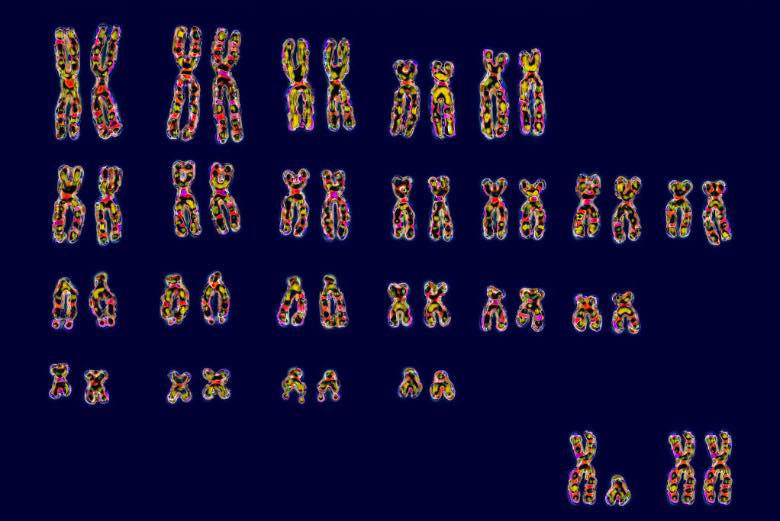The internet says that identical twins are 100% identical and that all humans are 99.9% genetically the same, but that we share 99% of our DNA with chimpanzees. Does this mean that another person is only 0.9% more like us than a chimpanzee? What’s more, humans are said to share 50% of our genes with a banana, but 50% with each of our parents. Do we share the same genetic similarity with a banana as with our own mother, and even more with this tropical fruit than with our grandmother, to whom we are only 25% similar? Obviously, this is not the case; different concepts are being confused.

All living beings on Earth originally came from the same ancestor, a single-celled life form that lived almost four billion years ago and is called LUCA (Last Universal Common Ancestor). Therefore, all creatures on this planet share a genetic inheritance from LUCA, and we all resemble each other genetically to some extent the more closely related we are.
As a result, there may still be up to a thousand similar genes between humans and bacteria, the creatures most distant from us in evolutionary terms, the ones we resemble least. Given that the human genome harbours some 20,000 protein-coding genes, this is not a negligible resemblance, and it is proof—though not the only proof—of our common origin.
Not-so-identical twins
But the genetic changes from LUCA to any species today have been immense, and so are the differences between them. To return to the case of bacteria, they have only one very simple chromosome, a single strand of circular DNA, whereas humans have 23 pairs of chromosomes with a very complex structure. Chimpanzees and other great apes have 24 pairs of chromosomes.

The greatest degree of genetic similarity is found in identical twins; they are natural clones, so their genomes start out as two peas in a pod. But this is only at the beginning of embryonic development: as cells divide, spontaneous mutations can occur that are passed on to daughter cells. A 2021 study of the genomes of 387 pairs of monozygotic twins found that only 38 were 100% identical; the rest had an average of 5.2 developmental mutations that set them apart, and 39 pairs had more than 100 mutations.
This means that if you line up the genomes of two identical twins on top of each other, the sequence of their bases—the letters of their DNA—will be exactly the same, except at those points where mutations have occurred. If you do the same for the genomes of any two unrelated people, you will see, on average, one difference every 1,000 bases, or 0.1%; it follows that people are 99.9% genetically the same. Applied to the whole genome, with just over three billion bases in each set of chromosomes (paternal or maternal), this means that there are about three million genetic differences, or six million in the 46 chromosomes.
The fact that we get one set of chromosomes from our father and one from our mother means that 50% of our genome comes from each of them. But this does not refer to specific differences in the sequence. Each gene, for example the one that produces insulin, can be found in humans in several slightly different variants, or alleles. In humans, the insulin gene is located on chromosome 11. We have two chromosomes 11 and therefore two insulin genes. But it is possible for both to be identical if our father and mother had the same alleles.
Common genes or proteins?
Our genetic similarity to other species is a different kettle of fish. Humans and chimpanzees are so similar that large parts of both genomes can line up. In these parts, if we only look at the specific changes in the gene sequence, the genes are 98.77% identical. If the different fragments are included, a similarity of 96% was estimated, although this figure is disputed. If we look at the sequence of the proteins we share, only 29% of them are completely identical.
With regard to the figures circulating about our genetic similarity to flies or bananas, there is a bit of a catch. Researchers do not compare our entire genome with that of another species; if you try to do that, we are only 32% similar to a mouse and 1% to a zebrafish. Instead, they look for genes or proteins that we have in common, called orthologues, to analyse how similar they are. As an example, humans are similar to one another in 100% of our genes and 99.9% of their sequences.

When making this comparison between humans and bananas, our orthologous proteins are about 40% similar; this is where the claims you find on the internet come from. But in reality, these orthologues make up at most 25% of our genes. And given that genes occupy a very small part of the genome, 1-2%, if we combine these figures in a calculation that is not intended to be rigorous but illustrative, we can obtain the similarity between our genome and that of the banana plant: more in the order of 0.1%.
Comments on this publication